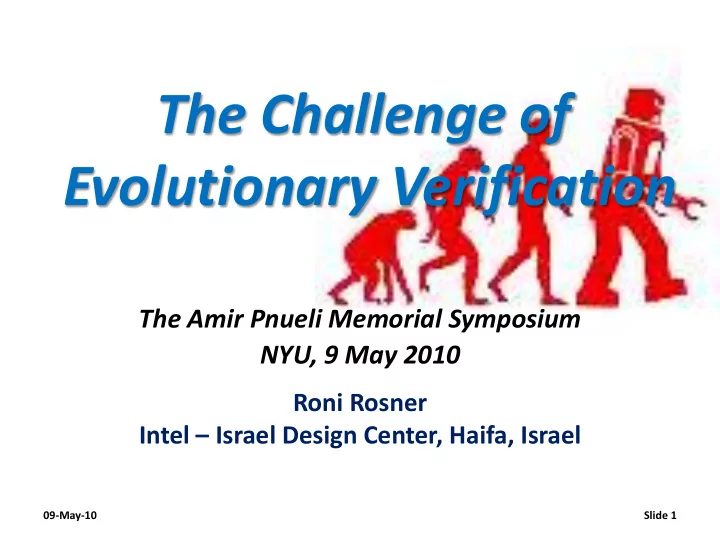

The Challenge of Evolutionary Verification The Amir Pnueli Memorial Symposium NYU, 9 May 2010 Roni Rosner Intel – Israel Design Center, Haifa, Israel 09-May-10 Slide 1
The Four-Color Theorem • 1852 : Guthrie conjectured Every planar map is four-colorable • 1976 : Appel & Haken proved the theorem using an assembly program on a IBM 370-168 computer • 2004 : Gonthier verified the proof of the theorem using the Coq proof checker • 2005 : Devlin [Math. Assoc. America] announced Last doubts removed about the proof of the Four Color Theorem • 2006 : Harrison partially verified HOL light, the logical kernel of Coq, using HOL light itself • … Even for most non-typically well defined problem - math, formalization and verification are not so easily attainable 09-May-10 Slide 2
A Different Aspect of Uncertainty 1976 layers 2004 layers • Assembly program • Data: proof • Assembler • Application: proof-checker • Operating system (with • Compiler(s) VM!) • Operating system + updates • Mainframe • Dual-core system • Network connection 09-May-10 Slide 3
A Typical Application 2010 layers Dynamic aspects • Runtime downloadable data / • Data scripts • Application • Dynamic libraries • Dynamic compilation • Compiler(s) • Online SW updates • Operating system(s) • Anti virus at the background • Viruses • Virtualization layer(s) • OS patches • Multi core / multi processor • Virtualization layer • Cloud computing • Heterogeneous network • … The interfaces between abstraction layers as well as inside layers get more complex , dynamic and unstable – more reasons for doubts!!! 09-May-10 Slide 4
Outline • Motivation and conception of an “evolutionary” approach for verification • Supporting examples • Initial thoughts about potential directions 09-May-10 Slide 5
Motivation • Verification task refers to a single, isolated transition – Given model, system, assumptions, specification – Apply an algorithmic verification process – Desired correctness outcome: once proved - done forever • Modern systems are of a more progressive nature – Systems evolve, assumptions change – Underlying models adapt, correctness criteria get refined – Verification methods improve, adjust – Correctness concerns are never fully satisfied • Hypothesis – System’s fast evolution and complexity make it increasingly inefficient / impossible to target system time-snapshots by isolated verification tasks 09-May-10 Slide 6
Proposal: Evolutionary Verification Challenge : Extend the scope of formal-methods research from (isolated) verification tasks to the context of (evolutionary) verification process This requires the development of a formal framework that can adapt to and express the evolution of • Specifications • Computational/programming model • Verification methods • Correctness criteria and metrics • Methods for handling intermediate, incorrect states … and their ongoing integration into the implementation process. 09-May-10 Slide 7
Put into Historical Perspective Strongly Inspired by some of Amir Pnueli’s Major Contributions Verification Verification Task Task Valid! Valid! Input Input* Adding time and state to Transformational Reactive the system and its spec System System Adding laziness to the verification process Verification Verification Task Process Valid Input Adding time and state to P for P! the verification process??? Compiler Evolving System 09-May-10 Slide 8
Case for Evolution (1) - Racing • Characteristics – Systems are too complex to fully verify in advance – System’s (at least initial) reaction/output is required earlier than full verification can complete • Examples – Just in time (JIT) compilation – Dynamic binary optimizers (DBO) – Virtualization layers 09-May-10 Slide 9
Case for Evolution (2) - Unpredictability • Characteristics – System behavior is changing dynamically – Modes of operations / usage environments are amorphous / not known in advance • Examples – WEB applications, e.g. Java scripts – Viruses and anti viruses – Operating systems – Server networks – Cloud computing 09-May-10 Slide 10
Case for Evolution (3) - Maliciousness • Characteristics – Optimized systems – Explicit interfaces (e.g. ISA, programming model) are preserved, yet implicit assumptions of the applications are broken – Knowledge of implementation details enables unexpected attacks • Examples - RSA encryption – Side channel attack on the Secure Socket Layer (SSL) protocol (protecting online transactions) – Exploits intimate knowledge of HW optimizations such as caches and branch prediction – Exploit intimate knowledge of the algorithmic implementation of the protocol – Utilize “innocent” OS features such time sharing to “spy” into the protocol – Gain observability into tiny timing effects uncovering the private key 09-May-10 Slide 11
So How Evolution? • All three cases (racing, unpredictability, maliciousness) have several characteristics in common – Complexity – Impossibility to validate in advance – A sense of continuous struggle for correctness – Need to tolerate intermediate failures • Can “incessant, lazy - verification” become a more robust evolutionary model? – Specification, verification are building blocks of the continuous design process • While competing for system resources, need to address – How to manage the evolving specification, correctness status – What to do about incorrect output? – How to fix a failing system? – How to improve verification over time (learn)? 09-May-10 Slide 12
Why is Evolutionary Verification an “Appropriate” Challenge? • Interesting? – subjective • Difficult? – necessary, not sufficient • Inspired by real world problems • Has the potential of expanding the scope and outreach of formal methods, by – Addressing some fundamental questions about the very nature of formal models • What is a (good) specification? • What defines the limits and the desired flexibilities of a formal model? – Allowing for better design engineering 09-May-10 Slide 13
Partial List of Related Trends and Potential Directions • Open Verification Methodology (OVM) intiative • Subject/aspect oriented programming – Separation of concerns • Self verification – Assertions – Artificial intelligence methods – SHADOWS • Any method of gradual verification – Bounded model checking • Many relevant ideas I heard in the first day of the symposium 09-May-10 Slide 14
Thank You 09-May-10 Slide 15
Recommend
More recommend